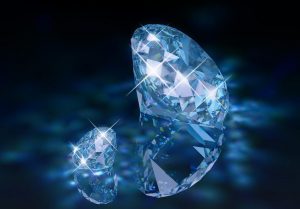Aquamarines are famous gemstones that are found in various parts of the world. Aquamarine belongs to Beryl family of which emerald is a famous member. The colors of aquamarines range from light blue to deep blue. Apart from contributing to the uniqueness, the brilliant glow of aquamarines, their transparency and brilliance of internal reflections determine the value of these gemstones. Mostly aquamarines are heated so that yellow color components in the gemstones are removed. The heat treatment results in permanent change of color. Since the color and transparency decide the value of aquamarines, these gemstones range in prices as well. Blue topaz, either glass or synthetic is promoted as aquamarine. Hence, it becomes necessary to know how to identify the right aquamarine gemstones so that you are not fooled into buying glass in place of gemstones. Here are some suggestions to help you with making the right identification.
1) It is difficult to identify aquamarine based on the color. Hence, look out for scratches on the surface. Aquamarine gemstones are hard and they are not easily scratched. Glass, as you know, is easily scratched.
2) Aquamarine has the quality to display different colors when viewed from different angles whereas glass will display the same color regardless of the angles you look at. Hence, look from various angles and if you see different colors displayed, you have aquamarine on your hand.
3) Another easy way that helps with identifying aquamarine gemstones is to place the gemstone on your forehead. Since, aquamarine is cool, you will feel cool when it comes in contact with your forehead. Glass, on the other hand, feels like room temperature.
4) If you are unsure about the gemstone on hand, you could check for refraction. Blue topaz is refractive and hence you could find stronger refraction lines unlike in aquamarine, which is weakly refracted. Look into the gemstone to find out if there are doubling of lines. If you could spot the lines easily, then it could be topaz. If not, it is aquamarine.
5) You could also check if the stone has any bubbles inside. Aquamarine does not have any bubbles inside. If you notice tiny bubbles inside the stone, then it is glass that you are holding.
6) Use a microscope to look at the internal crystalline structure. When viewed through gemological microscope, the hexagonal shape of the gemstone can be viewed on the inside.
7) Consult a gemologist you know to find out about the genuinity of the stone on hand. A professional will be able to guide you adequately. Moreover, equipments for performing the tests will be available with him and hence you could expect an accurate judgment.
When you plan to invest in aquamarine gemstones, it would be wiser to reach for your jeweler with whom you had been dealing all along. Acquire information before hand on the various details about aquamarine gemstones such as the colors of the gemstones, their transparency, shapes, internal structures and hardness levels. However, do not conclude based on the knowledge you recently acquired through books and blogs. The knowledge is sure to guide you; however, it is a professional you trust, who would be able to make you get your money’s worth.


























